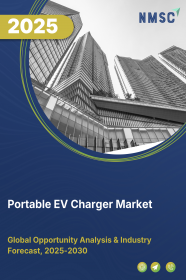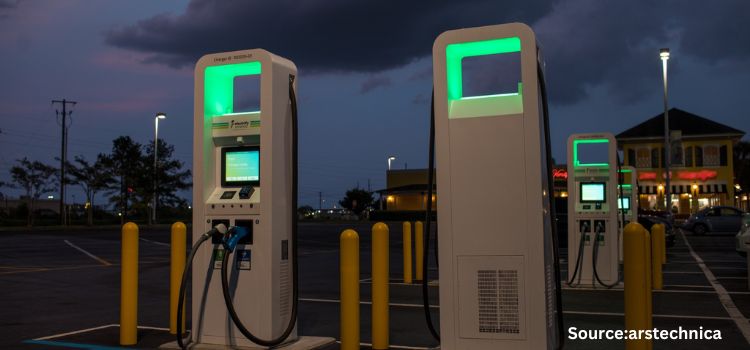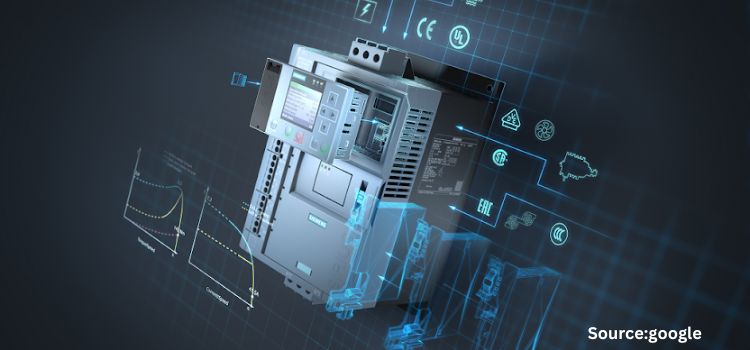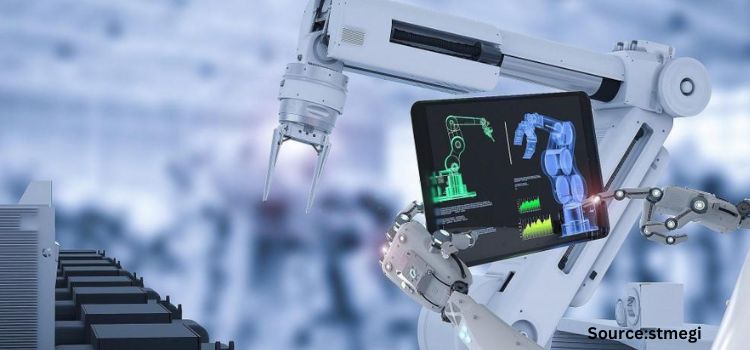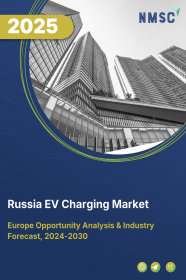
Russia Electric Vehicle (EV) Charging Market by Charging Type (Off-Board Top-Down Pantograph, On-Board Bottom-Up Pantograph, and Charging Via Connector), Charging Voltage Level (Level 1 (<3.7 KW), Level 2 (3.7–22 KW), and Level 3 (Above 22 KW)), Charger Type (Slow Charger and Fast Charger), Vehicle Charging (AC, DC, Inductive Charging), Application (Commercial and Residential), Commercial (Commercial Public EV Charging Stations and Others– Opportunity Analysis and Industry Forecast 2023–2030
Industry: Automotive & Transportation | Publish Date: 09-Apr-2025 | No of Pages: 171 | No. of Tables: 132 | No. of Figures: 77 | Format: PDF | Report Code : AT864
US Tariff Impact on Russia EV Charging Market
Trump Tariffs Are Reshaping Global Business
Market Definition
Russia Electric Vehicle (EV) Charging Market was valued at USD 167.86 million in 2022, and is predicted to reach USD 1443.3 million by 2030, with a CAGR of 31.6% from 2023 to 2030. Electric vehicle chargers are characterized by the rate at which they deliver energy to the vehicle's battery. They serve as a vital infrastructure connecting plug-in electric vehicles to electrical outlets for the purpose of recharging the vehicle's battery. These chargers facilitate the charging process by supplying the necessary electrical energy to the EV's battery.
Charging stations are compatible with electric vehicles, neighborhood electric vehicles (NEVs), and plug-in hybrids, allowing them to connect to an electrical source for charging. Some charging stations come equipped with advanced functionalities such as smart meters, cellular connectivity, and network access.
The charging of EVs can be carried out through several levels of charging such as level 1, level 2, and level 3. The higher the level of charging, the faster the charging process causing more power to be delivered to the vehicle. The use of electric vehicles significantly reduces the carbon footprints released into the atmosphere, which contain toxic gas. The growing threat of carbon emissions and other harmful gases stemming from transportation has triggered the vital necessity of adopting electric vehicles.
In addition, the penetration of EV charging is high in commercial spaces as compared to residential ones. Long-distance trips would benefit from ultra-fast charging capabilities made possible by public charging infrastructure. However, EV chargers for residential spaces offer significant growth potential as they are affordable and more convenient for charging electric vehicles as compared to commercial charging stations.
Government Initiatives Drive Electric Vehicle Charging Services in Russia, Strengthening the Automotive Industry
The automotive industry is a significant sector in Russia, employing approximately 600,000 people, which represents 1% of the country's total workforce. In 2018, Russia manufactured 1,767,674 vehicles, making it the 13th largest car producer globally, accounting for 1.8% of worldwide production. Government initiatives to promote electric vehicle production in Russia have also bolstered the development of electric vehicle charging services in the country. For instance, in August 2021, the Russian government’s electric transport development program announced that the production of EVs should reach 10 % of all cars produced by end of this decade.
Rise of Autonomous Vehicles and Driverless Ride-Sharing Boost E-Mobility Services in Russia
The acceptance of autonomous vehicles in Russia, especially those enabling driverless ride-sharing, is significantly advancing the country's e-mobility services. These self-driving vehicles are transforming transportation by providing efficient and convenient mobility without human drivers. It is not only improving accessibility and convenience for passengers but also aligning with the broader shift towards electrified and sustainable transportation.
As a result, the integration of autonomous technology is propelling the growth and evolution of e-mobility services in Russia, ushering in an era of efficient and environmentally friendly transportation solutions. For instance, in March 2020, the Russian government planned announced the development of autonomous cars as one of its priorities in the field of transportation within the next several years.
Fast Chargers' High Initial Setup Costs Hinder the EV Charging Market Growth
The absence of incentives and concerns about the steep installation expenses for EV chargers could hinder the sector's growth. One of the most significant obstacles to expanding this industry is the substantial upfront cost associated with level 3 and ultra-fast chargers. While level 1 and level 2 chargers can require anywhere from 6 to 16 hours for a full charge, consumers are accustomed to refuelling their conventional fossil fuel vehicles in just 5 to 7 minutes.
Fast chargers that can charge EVs in under 30 minutes are therefore in demand on the market. A level 3 charging station can be somewhat expensive at first, though. For those who might want to transition to EVs, this could be a deterrent because a lengthy charging period might interfere with their already hectic schedules.
Surging Adoption of Vehicle-to-Grid (V2G) EV Charging Stations in Russia Unlocks Promising Opportunities
A technology called vehicle-to-grid (V2G) EV charging allows plug-in EVs and the power grid to exchange electrical energy in both directions. Electric vehicles (EVs) can store extra electricity and release it to the grid thanks to V2G technology. This may enhance the functionality of the electrical component and increase value for EV owners.
The development of this concept has made charging for electric vehicles easier, and EVs are now among people's top transportation options. As a result, the entire market for charging stations is essential for connecting the electric vehicle to the grid and enabling the vehicle to charge.
Two V2G EV vehicle charging stations were erected by Enel Energia S.p.A. at the Italian Institute of Technology's Genoa headquarters. The installation is a part of MOV-E, a Nissan-sponsored corporate electric car sharing trial project. The Italian Institute of Technology received two battery electric vehicles (LEAF models) from Nissan as well as the Glide app management platform. The partnership between Enel and Nissan represents a shift in the way that technology is used for sustainable transportation.
As a result, manufacturers have a great chance with the V2G charging technology because it is predicted to change the EV industry and determine how EVs will be charged in the future. Although V2G infrastructure is more beneficial than smart charging, installing V2G charging stations has a hefty up-front cost. Manufacturers of EV connectors are projected to have opportunities to produce sophisticated connectors to withstand electrical architecture due to the predictable and anticipated expansion of V2G technology.
Competitive Landscape
The Russia Electric Vehicle (EV) Charging industry includes Shell Plc, Rewatt, ABB Ltd., Luoyang Grasen Power Technology Co.,Ltd., SparkCharge, Allegro MicroSystems, Inc., loCharger, EVB, Rosneft, Kempower Oyj, Schneider Electric, Efacec, Rosseti, Gazprom Neft, RusHydro.
Key Benefits
-
The Russia Electric Vehicle (EV) Charging market report provides a quantitative analysis of the current market and estimations through 2023-2030 that assists in identifying the prevailing market opportunities to capitalize on.
-
The study comprises a deep dive analysis of the market trend including the current and future trends for depicting the prevalent investment pockets in the market.
-
The information related to key drivers, restraints, and opportunities and their impact on the market is provided in the report.
-
The competitive analysis of the market players along with their market share in the Russia Electric Vehicle (EV) Charging market.
-
The SWOT analysis and Porter’s Five Forces model are elaborated in the study.
-
Value chain analysis in the market study provides a clear picture of the stakeholders’ roles.
Russia Electric Vehicle (EV) Charging Market Key Segments
By Charging Type
-
Off-Board Top-Down Pantograph
-
On-Board Bottom-Up Pantograph
-
Charging Via Connector
By Charging Voltage Level
-
Level 1 (<3.7 KW)
-
Level 2 (3.7–22 KW)
-
Level 3 (Above 22 KW)
By Charger Type
-
Slow Charger
-
Fast Charger
By IOT Connectivity
-
Non-Connected Charging Stations
-
Smart Connected Charging Stations (Networked)
By Vehicle Charging
-
AC (Normal Charging)
-
DC (Super Charging)
-
Inductive Charging
By Application
-
Commercial
-
Residential
By Commercial
-
Commercial Public EV Charging Stations
-
On-Road Charging
-
Parking Spaces
-
Destination Chargers
-
-
Commercial Private EV Charging Stations
-
Fleet Charging
-
Captive Charging
-
By Installation Type
-
Portable Charging
-
Fixed Charging
-
Wall Mount
-
Pedestal Mount
-
Ceiling Mount
-
By Charging Standard
-
CCS
-
CHADEMO & GB/T
-
Type 1/Normal Charging
-
Tesla Super Charger
-
Type-2
-
Level 3
Key Players
-
Shell Plc
-
Rewatt
-
ABB Ltd.
-
Luoyang Grasen Power Technology Co.,Ltd.
-
SparkCharge
-
Allegro MicroSystems, Inc.
-
loCharger
-
EVB
-
Rosneft
-
Kempower Oyj
-
Schneider Electric
-
Efacec
-
Rosseti
-
Gazprom Neft
-
RusHydro
REPORT SCOPE AND SEGMENTATION:
|
|
|
|
|
|
|
|
|
|
|
|
|
|
|
|
|
|
|
|
|
|
|
|
|
|
|
|

















 Speak to Our Analyst
Speak to Our Analyst





